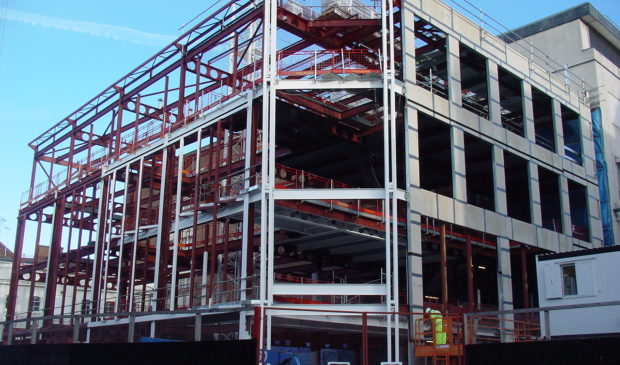Council approves new mixed-use development rules and launches separate corridor proposal
Monday, June 13, 2022 by
Jonathan Lee In response to Austin’s housing crisis, City Council passed two policies Thursday to allow more housing along major streets.
“I think it’s more critical now than it has ever been to increase density and housing on these corridors,” Mayor Steve Adler said. “And I think that’s our existential challenge.”
Though housing advocates have urged more drastic changes, Council has remained committed to passing consensus policies following a court ruling on the right of property owners to protest rezonings.
The first set of changes applies to Vertical Mixed-Use zoning, a density bonus program that relaxes some development constraints in exchange for affordable units. Now, developers can build even taller – up to 90 feet – if they provide more affordable housing.
The ordinance, which goes into effect immediately, splits VMU into two tiers. The first, VMU1, does not grant additional height but requires slightly more affordable housing – 10 percent of rental units must be affordable to those making 60 percent of the area median family income. The next tier, VMU2, grants an additional 30 feet of height if developers set aside either 12 percent of units at 60 percent MFI or 10 percent of units at 50 percent MFI.
The affordability requirements proved contentious. Council Member Ann Kitchen, who sponsored the VMU changes, had pushed to require more affordable units in VMU2, bumping the percentages to 15 and 12 percent instead of the staff recommendation of 10 and 12 percent. “I personally think that we’re not pushing the envelope enough,” Kitchen said.
But others had concerns. “When we miscalibrate these numbers, we end up not getting any projects built at all,” Council Member Paige Ellis said.
Council initially voted 6-5 in favor of Kitchen’s affordability requirements, but in a moment of late-night drama, Council Member Mackenzie Kelly changed her vote, swinging the majority in favor of the lower percentages. Council members Vanessa Fuentes, Kathie Tovo, Alison Alter and Leslie Pool joined Kitchen in pushing for increased affordability.
Whether the requirements are properly calibrated is “hard to say” without financial modeling, Erica Leak with the Housing and Planning Department said. To avoid shot-in-the-dark calibration going forward, staffers have discussed creating a “streamlined and regular way to update percentage set-asides and fee-in-lieu calibrations.”
VMU2 projects on the Project Connect Orange and Blue light-rail lines will have to make 15 or 12 percent of units affordable. The higher requirement is offset by reduced compatibility and parking requirements along the lines, where both VMU1 and 2 projects will only need to build 25 percent of the parking otherwise required by code, and where compatibility will only apply within 100 feet of triggering properties compared to the 540 feet of distance that typically applies.
To encourage family-sized affordable units in VMU buildings, the bedroom counts for both the affordable and market-rate units must align.
Looming over the discussion was a March court ruling on property owners’ right to petition zoning changes and force a 9-vote supermajority at Council.
Attorney Douglas Becker, who represented the plaintiffs in the suit, threatened to sue the city again over VMU changes. “Changes to the land use regulations on VMU properties without providing written notice and protest rights, as required by state law and the district court as affirmed by Acuna et al. v. City of Austin, subjects the city to further costly litigation,” Becker wrote in a letter.
Kitchen aimed to guarantee a right to protest by forcing VMU2 projects to go through an individual rezoning, calling it a matter of “fundamental fairness and respect for the public.” Other members, however, argued that VMU2 should be by right – meaning that developers wouldn’t need additional Council permission to build. Council voted 7-4, with Pool, Tovo, Kelly and Kitchen against, to make VMU2 by right.
In a separate discussion, Council voted to start the process of reducing compatibility and parking requirements along busy streets throughout the city – a complex proposal that the Austin Monitor recently covered in depth.
Council members say the regulations hurt housing supply at a time when the city needs as much new housing as it can get. Compatibility constrains many sites throughout the city, making projects smaller or unfeasible, and parking requirements add to the cost of building and, some say, promote car dependency when the city’s long-range plans call for less driving.
Under the proposed changes, compatibility would apply within 300 feet from a triggering property and the rule’s height limits would increase by 5 feet. Parking requirements would be reduced depending on the category of street.
Much discussion is still to come; the exact reductions in compatibility and parking requirements (and the streets where the reductions would apply) are far from settled. The resolution directs city staffers to bring a draft ordinance for Council consideration no later than September.
Photo by Rept0n1x, CC BY-SA 3.0, via Wikimedia Commons.
The Austin Monitor’s work is made possible by donations from the community. Though our reporting covers donors from time to time, we are careful to keep business and editorial efforts separate while maintaining transparency. A complete list of donors is available here, and our code of ethics is explained here.
You're a community leader
And we’re honored you look to us for serious, in-depth news. You know a strong community needs local and dedicated watchdog reporting. We’re here for you and that won’t change. Now will you take the powerful next step and support our nonprofit news organization?



